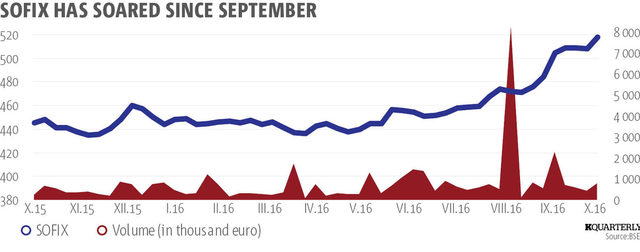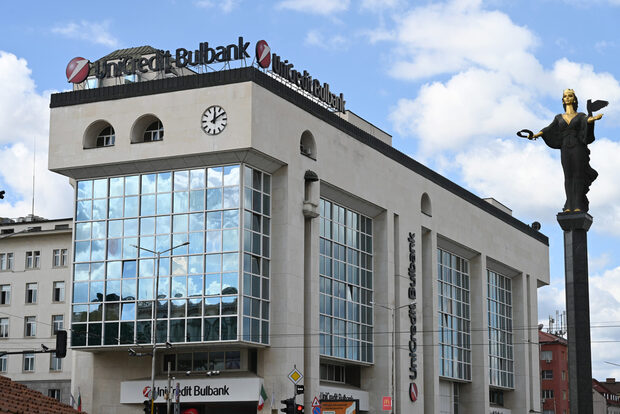For about a year the SOFIX, the benchmark index of the Bulgarian Stock Exchange, drifted without direction but now it seems ready for prime time sail. The launch of an exchange-traded fund based on the SOFIX and the arrival of mostly retail inflows catapulted the index by almost 10% in the final weeks of the third quarter of 2016.
The 11% rise of the SOFIX year to date (as of 20th of October) ranks the Sofia stock market second only to regional leader Croatia (+19.8%), leaving behind Romania and Serbia (0%) and Greece (-4.37%.) The engine behind this surge is typical for every developed market - low real yields on government securities, abundant free liquidity, real estate appreciation or, in short, the presence of the notorious beauty TINA (There Is No Alternative).
While the minority coalition government of PM Boyko Borissov looks stable, it is fragile and prone to both inside and outside pressures. Regional uncertainty is stoked by Greece's financial woes, political turbulence in Turkey, Russia's push to restore its influence in the Balkans and more generally the increased frictions between Moscow and the West. Not to forget the migration crisis and the EU in turmoil after Britain's decision to leave the bloc.
On the bright side, the Bulgarian economy added 3% in the first half of the year, unemployment fell to 8% and tourism is likely to give a considerable boost to Q3 GDP. Inflation is hovering around zero (-0.8% y/y in September) and the government maintains a healthy budget surplus equivalent to 3.5% of GDP as of the end of June.
The Bulgarian banking sector faced its worst crisis since the 1997 meltdown as the country's fourth largest lender, Corporate Commercial Bank, collapsed in 2014. Sentiment quickly went dour and just lately began to recover. Real estate prices were the first beneficiaries, supported by low interest rates, with the capital Sofia leading the way with 11.5% annual appreciation as of June 2016. The successful passing of recent stress tests by local banks and the hopefully identical performance of insurers and pensions funds will help further alleviate investment insecurity on the stock market. The newly elected Bulgarian financial watchdog and the government's rediscovered awareness of the capital market (the support with public money for new IPOs, for example) are positive whiffs.
Even though fundamentals look well, the Bulgarian stock market is not a meal for those who can't scratch beneath them. On the surface, the most closely followed price/earnings ratio is 10 and looks strikingly good. But the results are heavily skewed by the profits of a single company, Chimimport. Browsing through its financial statements poses a challenge and requires specific knowledge and one should be careful spotting accounting gimmicks and shenanigans. Thus, company specific approach is a superior strategy to indexing. Though there are few well-behaved blue chips, long lasting investments are in doubt given the shortage of quality companies, as well as the relatively small size, tiny liquidity and governance issues.
Liquidity remains a concern. The average daily turnover - around half a million euro, low free float, few traded issues and relatively small market capitalization of the companies are endemic issues. These problems pose a natural barrier to big foreign investors. The recent efforts of stock exchanges in the region to create a common trading platform were a step in the right direction, albeit a small one.
The surge in the SOFIX can be attributed mostly to retail clients, with institutionals still stuck in a wait-and-see mode. Yields on bank deposits are close to nothing and, naturally enough, people start looking for alternatives. While real estate is the first choice by far, savers are slowly warming to stock markets.
Pension funds, long absent from the headlines, recently acquired a 3.5% stake in Monbat, one of the blue chips. They have accumulated huge assets under management and can easily become a determining factor, yet it is too early to say that tides are turning. The return of the IPOs - most notably the public offerings of the IT companies Sirma and Alterco, is another sign of companies beginning to chase the abundant money looking for a place to park.

Technically speaking, after a long consolidation, a powerful move in either direction can be expected. There is a clear impulsive upside breakout and an ongoing test which, if valid, opens a path for further gains into year-end and probably targeting 2014 highs. The longer-term determinant of the trend, the 200-day moving average and the shorter-term 50-day moving average are upward sloping, and supportive. That said, the upward move is a bit extended and some digestion is on the agenda.
The verdict is: the market is susceptible to an explosive move, but roots are shaky and can easily wither.
Krasimir Atanasov is private investor and investment consultant.

For about a year the SOFIX, the benchmark index of the Bulgarian Stock Exchange, drifted without direction but now it seems ready for prime time sail. The launch of an exchange-traded fund based on the SOFIX and the arrival of mostly retail inflows catapulted the index by almost 10% in the final weeks of the third quarter of 2016.
The 11% rise of the SOFIX year to date (as of 20th of October) ranks the Sofia stock market second only to regional leader Croatia (+19.8%), leaving behind Romania and Serbia (0%) and Greece (-4.37%.) The engine behind this surge is typical for every developed market - low real yields on government securities, abundant free liquidity, real estate appreciation or, in short, the presence of the notorious beauty TINA (There Is No Alternative).









